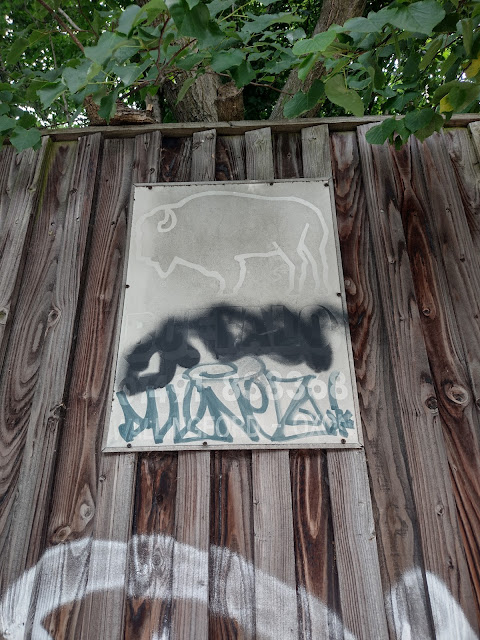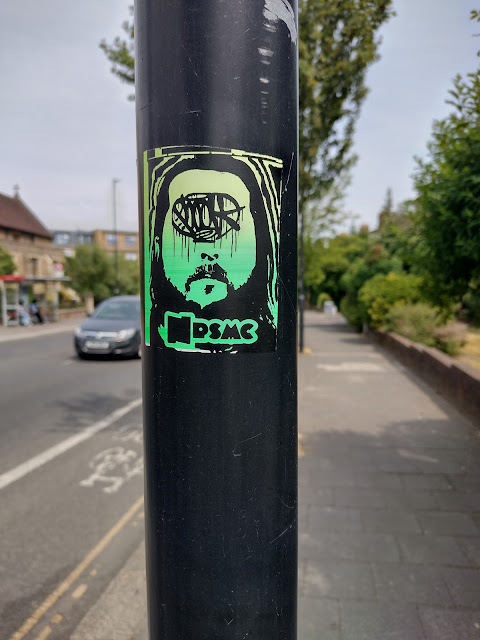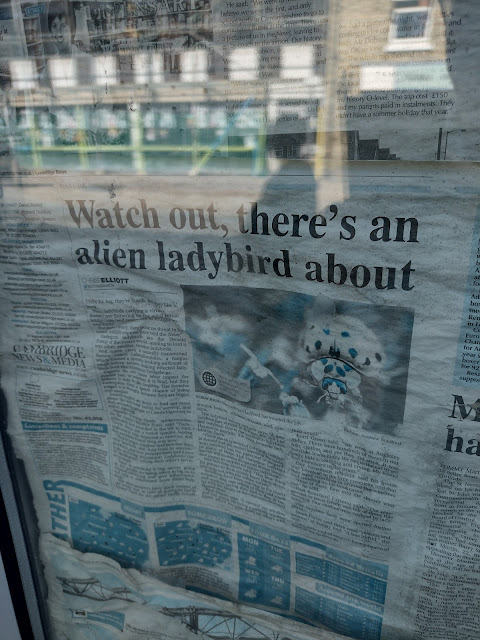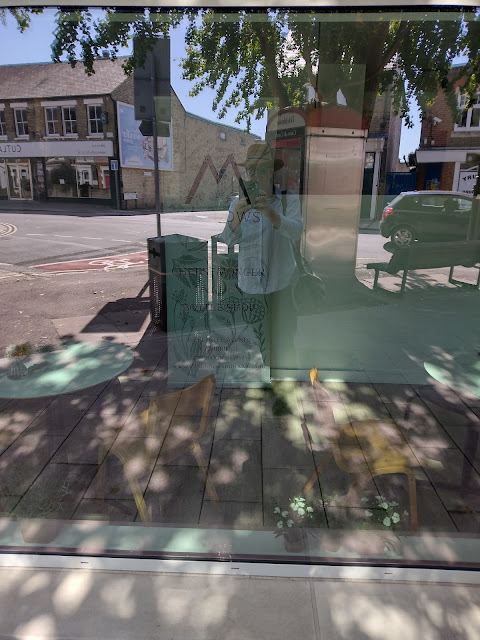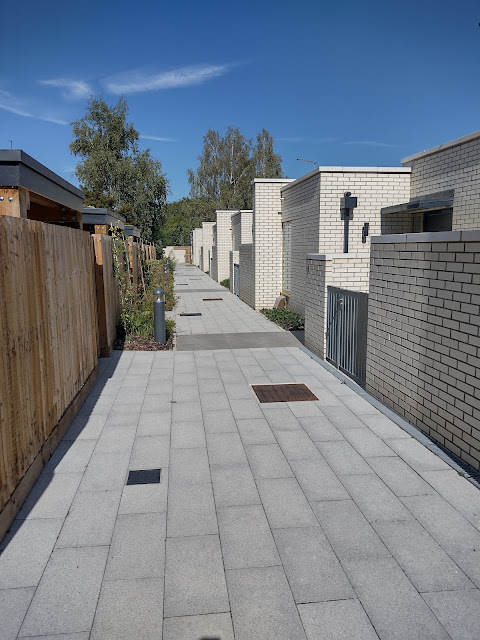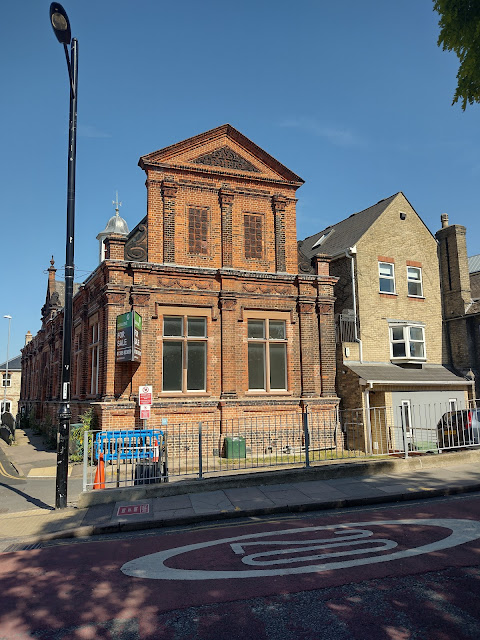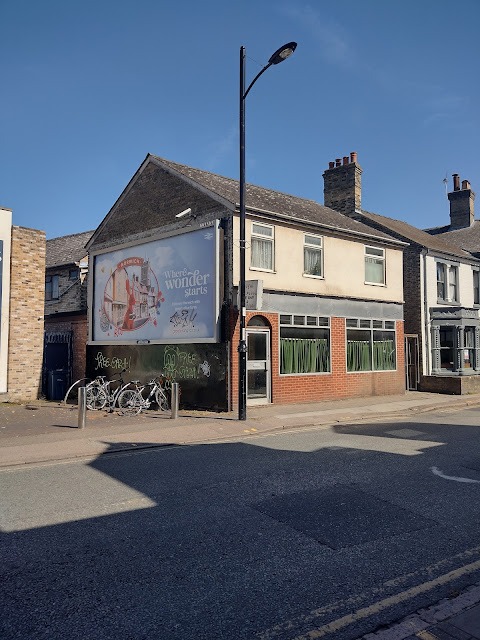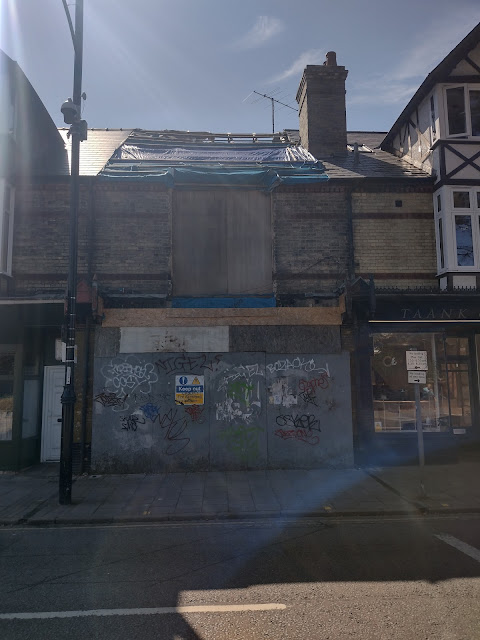I had seen it, several times out of the window as the train passed through the Northern outskirts of London. Somewhere near New Southgate, or so I thought. Its not easy to read the station signs in the run up to Finsbury Park. The distances between the stations at train speed is short. A less than rigorous internet search mentioned the last gas holder in New Southgate as if it was a thing of the past. New flats had been approved, according to the Enfield Independent in December 2021. But soon after reading that, on another trip to London I saw the gasholder again looming up briefly as the train sped past.
I made a subsequent trip to see if I could find the gas holder. I didn't see it from the train window on the way towards London. I got distracted whilst in the vicinity and forgot to look. The search for the gasholder was the catapult (or excuse) for a wander around an area I used to pass through a lot and live not far from when I was a student. When viewed through the lens of hindsight mixed with a weird sort of nostalgia for the places I'd never been, I saw the area as somewhere I hadn't explored nearly as much as I should have at the time. There was, thirty odd years later, still much uncharted territory to traverse and get lost in. The plan, such as it was, involved finding the gasholder and then meandering to The Fishmongers Arms near Wood Green, a former pub which was still open when I was a student. Like many of the streets in the surrounding area, the pub was never visited by me at the time. There is no explanation I can think of as to why. But we mainly slept in Wood Green and rarely went out in it, instead heading further South for beer and entertainment. The Fishmongers Arms must have been the nearest pub to Arcadian Gardens, which was where I shared a house at the time. Just off the High Road, which is what Green Lanes briefly turns into along that stretch.
After emerging at Bounds Green and taking a reasonable breakfast at the Sunrise Cafe nearby, I headed towards New Southgate Station across 'The Green', an elongated green corridor sandwiched between the houses of Tewkesbury Terrace and The Bounds Green Road. This threw me out the other end near the junction with the North Circular Road. The junction was immediately disorientating. I could remember coming across it on the bus from North Finchley, another place I lived as a student. I had taken the bus journey most days for about a year in order to catch the tube at Bounds Green down to Finsbury Park. But my memories of the place from that time were so vague and distorted that they were counterproductive. Having decided that I wanted to walk free of google maps, and only refer to the paper A-Z if absolutely necessary, I turned right onto the North Circular in the mistaken belief I was on the road to New Southgate Station. I followed the road to my right and an unidentified water course to my left flowing through an inaccessible vegetated area. Away from the vortex of the junction, my sense of direction partially returned. I turned off at the first opportunity into a a series of streets named after poets; Chaucer Close, Milton Grove and Shakespeare Avenue. The last of these flung me into a passage which emerged onto a main road, featuring Arnos Grove Tube station. When I lived in Wood Green, I had imagined Arnos Grove as somewhere far more distant from Bounds Green. This only added to my current sense of disorientation and promoted a sense of freeness from the constraints of set routes, phone checking and worrying about destination. I began to think if I didn't get to New Southgate (the place I'd planned to properly start drifting) anytime soon, or indeed at all, then it wouldn't really matter. But Charles Holden's iconic tube station design design resembled, in my current obsessed state, a gas ring. An optimistic sign that I was on the right track.
After following the main road for a bit, I veered off left and after wandering through a small and detritus infested park opposite a church, I found myself among the passages of a small housing estate behind some shops. I soon emerged onto the main road opposite New Southgate Station, the road I thought I was on about 20 minutes before.
I crossed the bridge over the railway tracks and emerged into a zone between the station and a wall that was clearly the remnants of a previous age. The wall had become colonised with street art and graffiti. The message on the wall directly in front of me was 'rest in peace'. My immediate thought was that this was a lament for the gas holder and I really was too late. Maybe the vision from the train window had been a mirage all along.
The wall stretched onwards but these days was an ineffective barrier between the station and what sits other side. Previously behind the wall had been large Victorian lunatic asylum, The Friern Hospital. But the vast site has since been turned to residential use. I walked through the archway where a door would have once blocked my way and onto the fringe of the still new(ish) looking housing development.
I followed a path along the other side of the wall which turned into a park. When presented with a junction, I took the path to the left which led to a green space with a circle of bushes and vegetation surrounding a dip in the ground, presumably an old pit of some type. There was no-one around. But evidence of people being here in the form of a discarded crisp, chocolate and coke picnic in one corner and a housing estate on the other side, demonstrated the area was far from a secret. But it felt off the beaten track despite the proximity of housing. I decide to walk around the circle, but as I got a quarter of a way around I saw what I first thought was someone's dog staring at me. But no person emerged and I realised it was a fox. Quite a big one. The creature stood still for what seemed a long time staring at me before turning and running off into the undergrowth. I decided to abandon my circuit and leave the fox in peace. Its sudden appearance had been slightly unnerving and the atmosphere of the space was somewhat off-kilter, in a 70s public information film sort of way.
I went back to the right hand path and soon emerged alongside a retail park. I decide to stop for some light refreshment, more due to the need to a wee than being thirsty. The best of very few options available was Costa Coffee where I sat outside and took in the view. I was glad I had taken breakfast at the Sunrise Cafe earlier since there appeared to be no decent breakfast options in the retail park, which I suppose is typical of these sorts of places.
I left the retail park and after crossing a bridge over a small lake, I emerged onto Atlas Road, which ran parallel to the North Circular. The road appeared deserted. It was only the sound of the traffic hidden by the trees to the left that reminded me I was in London, but otherwise I could have been walking through farflung peripheral region. The road's purpose had presumably become largely redundant once the North Circular had been built, other than to get to the retail park. But there was no sign of any retail park traffic, which presumably preferred Orion Road, on the other side of the North Circular. The names of the two roads brought about images of the titanic and galactic, but Atlas Road at least was the antithesis of those things. It did though have a strange and eerie feel to it.
A sign featured an image of a spectral bison, hinting that the fauna to be found behind the fence was probably something to beware of.
Similarly spectral was the advertising board. I wondered how long it was since anyone was tempted to advertise there. I reckoned I was the first person to see the board that morning judging by the number of people or cars I had seen along the road (none).
After a walk that was beginning to seem endless, I turned back to investigate an opening in the vegetation. This lead to a footpath that followed the Bounds Green brook. The path was as deserted as Atlas Road. Although netting supporting the banks of the brook from collapse showed that the watercourse was one not left to its own devices and carefully managed.
The path turned off into a residential area, the brook going its own way, impossible to follow. The residential area was non-descript and soon led to a main road. This road, for once, was not the North Circular or any of the other roads emanating from the vortex of the earlier junction. After crossing over and following the road beyond the large Tesco Extra to my left, I discovered I was on Colney Hatch Road.
The name Colney Hatch was both familiar and meaningless. I had no conception of it as a place. I was curious enough to break the rules and check the ordinance survey app. The name Colney Hatch appeared over an area not too far away, until I zoomed in a bit then it disappeared. Colney Hatch was both on and off the map. Wikipedia calls it 'loosely defined'. Further along the road, after crossing the North Circular, I encountered the crumbling edifice of Colney Food and Wine. The building seemed to me to be the most defined manifestation of the place 'Colney Hatch' I would find. The previously mentioned Friern Hospital asylum grounds extended to and was associated with Colney Hatch, the place name being used as an abusive term for madness as a result. The food and wine building looked like it might be one of the few surviving along this stretch contemporary to the asylum.
Colney Hatch is a place on the border of Haringey and Barnet. I had already traversed between the two boroughs, a fact only really noticeable by the local authority symbols on road signs. This part of Barnet was far removed from the Northern area where it merges with Hertfordshire. Here instead, it blends in with Haringey and Enfield to form an almost amorphous and extensive part of outer North London.
I turned down Albion Avenue. Although the battered street sign appeared at odds with any Arthurian or Blakean connections the name might have suggested, there was a definite change in atmosphere as soon as I entered the street. It had been another dry day and getting hotter. But as I passed the sign a very welcome light rain shower suddenly started. Attached to a wall on one of the houses was a brown terracotta sun, its alchemaic expression ambiguous.
At the end of the Avenue, which was not a long distance, was Halliwick
Recreation Ground. I sat on one of the benches surrounding the grassy
expanse. I looked at the A-Z to recalibrate and get my bearings. I soon
realised that I would be going completely the wrong way if I carried on
out the other side of the rec, in relation to the suspected site of the
Gas Holder around New Southgate Station. I'd come way off course. I
retracted my steps and instead followed the road down the side of Colney
Food and Wine.
Walking along the path alongside the North Circular felt odd. Although the path existed, it didn't appear to be very well used. Probably not surprising given the volume of traffic which seemed relentless. I approached a bridge, which featured the mark of the mysterious 'Ouch' emblazoned in black paint. The two crows circling overhead, vulture like, adding to the ominous atmosphere. Once under the bridge I was suddenly engulfed in a concentration of exhaust fumes and pigeon shit. The pigeon detritus and vehicle pollution had coalesced into a noxious tar-like murky film on top of the asphalt. This 'enhanced' the stench in the air and made walking feel like a significantly less than healthy activity for the duration of the underpass.
Around the corner was the road leading back to New Southgate Station. Across the road the new development included a Premier Inn and other buildings that looked almost identical to it but were probably flats. I speculated that they stood on the site where other gas holders had stood.
I crossed the road, and found myself as confused by the junction as I was the first time. I had assumed the road ahead lead to Bounds Green but soon realised I was wrong. The traffic was a relentless jam in all directions. An old lady was begging at the traffic lights of one of the junctions. It was an effective but dangerous looking strategy. The cars could go nowhere once the lights turned red and she approached them. I'd seen a younger woman doing the same earlier at another part of the junction. I somehow got sucked into the vortex of the junction again, and managed to find myself on the exact opposite side from where I realised I wanted to be. It took some time to get back to the right place, where I managed to orientate myself again on the road towards New Southgate Station and the newly developed area, which was presumably the one where flats had replaced gasholders.
Just before that I can remember the scene below which I think was across the road from the new development, on the still semi-industrial side where the large gasholder shown on the A-Z had been. But I couldn't swear to it.
But I recall with much more clarity seeing the enormous blue edifice of builderdepot.co.uk a little further along. The giant blue wall didn't look quite real, as if it had been superimposed by a computer graphic. It was hiding the railway line behind. I couldn't quite fathom the enormity of it.
I crossed the road and made towards the new development, which had been called Montgomery Park. An online search after the walk revealed nothing of the origins of this name, only that the place was a 'new chapter of city living'.
I emerged out the other side of Montgomery Park into a road belonging to an earlier era. I passed an older block, from a time when such places were called flats rather than 'apartments'. The car park/waste ground behind the fence was a much larger open space than any I'd noticed in the new development and looked like a prime place for football games and other 'vibrant' but possibly more dangerous social activities.
Less social was what would have been the only place to stop for a sit down near Arnos Grove Tube station, were it not for the potentially arse injuring spikes. The small corner, with it's no parking sign, was resolutely anti-social.
A little further along a green beared face confronted me from a lamppost. In place of eyes some sort of incomprehensible symbol or hieroglyph stared at me from the face. The visage was of a similar green hue to that of the turrets of the church. I wondered if it was a depiction of the head of St John the Evangelist in a hip mode, notifying passers by that they walked in his parish.
Beyond this a stretch similar to, but shorter than, the Palmers Green bit of Green Lanes gave way to a turn in the road, near the point where a Waitrose now occupied the former Green Dragon pub. The pub had closed in 2015. But a bit further along, at the start of a parade of shops was the Little Dragon, a micropub named in tribute that opened in 2017. I had noted earlier the heraldic symbol of Enfield Borough Council on the street signs of Green Lanes which I mistook for a Red Dragon, but in fact is a Red Enfield, a mythical beast that is an amalgam of fox, lion, eagle, wolf and greyhound. The creature is used in the heraldry of Enfield Borough as well as the emblem of some local schools, football clubs and other organisations. The Enfield is associated with the mythology of the O'Kelly family in Ireland but its not clear what the connection is between the beast and Enfield Borough. The Green Dragon, as a pub symbol, is associated with loyalty to the Earl of Pembroke, so connected to Wales. So although Winchmore Hill was physically heading towards and contained a slight whiff of Hertfordshire about it, there appeared to be a hidden Celtic connection somewhere below the surface.
Soon I was provided with some 'New River Path Safety Precautions' courtesy of an unmissable notice. The small print at the bottom pointed out that the New River brings fresh water from Hertfordshire into London and requested that people do not litter or let their dogs shit on the path.
I got back on and off the New River a few times, and the memory of which bit was which has become muddled in my miod since the walk. At some point I emerged back onto Green Lanes where the path separated the road from the river. Here a couple of engraved stones helpfully reminded passers by that the New River is neither new, nor a river. It was new once, when it was first opened but it was a choice of name that seems odd now. A bit like Sonic Youth. Although I suppose Sonic Youth probably didn't think they would still be a concern in their 40s, but presumably the New River was supposed to last a lot longer. And it has.
Various streets seemed to bear names related to the river, including River Avenue which ked me back on to a stretch of the New River featuring a few floating footballs. This part of the route seemed particularly vibrant. I still had encountered no other people on the path but here the ominous public information film element had completely disappeared. The greenery was particularly fresh here and there was no hint of the industrialised nature of the watercourse found elsewhere along the path.
I was forced to leave the path again for a short detour due to a 'danger keep out' sign and grey pointed metal fence prohibiting access to the next part of the New River. Eventually I rejoined it and walked alongside an extensive grey and graffitied warehouse of some kind. Again, there was no sign of any other human life. But the grim geeling brought on by the sludge had dissipated. I was enjoying the New River and its all but uninhabited low key mixture of greenery and low key defunct industrial structures.
I exited the New River path for the last time next to the building that fronted the long warehouse I had followed. The square brown premises of Chris & Sons Ltd did not look abandoned and although the shutters were down (it was Saturday) it appeared to be a going concern. A cursory glance at google while writing this confirms that it is, but what I hadn't realised was the road I stood on to take the picture was Green Lanes. I had stuck to my not using the map rule. This and the combination of heat and the slightly off kilter state resulting from having now walked some miles had contributed to my sense of orientation being more vague than normal. Still good enough for me to know I was heading in the right direction, just not exactly how.
I walked the length of Myddleton Road and although vaguely familiar it wasn't how I remembered the street I had bought my chips in. Maybe the 'chip shop' street was a figment of my imagination, and I'd been here at some other point, possibly when a friend of mine briefly lived near Bounds Green. I cannot be certain. Inevitably the street would have changed to some extent in thirty years, but I didn't recognise it at all.
I followed the High Road which although a road I walked up countless times years ago, felt a lot less familiar than I thought it should have done. In particular, I was amazed that I had no recollection whatsoever of the Civic Centre, the headquarters of Haringey Borough Council. The building looked contemporary to 60s/70s postwar Newtown Architecture. It is listed and due for a revamp according to the information board that extended along the front.
I was too weary to appreciate the rest of the stretch up to the Fishmongers Arms and decided a return trip in the near future was needed to do the area justice. I was glad when the now closed pub emerged into view. The pub had closed sometime in the 2000s and turned into flats. The building was not how i remembered it and had it not had the words 'Fishmongers Arms' still painted on it I would not have recognised it. I recalled it having a metal looking statue of John Lennon standing above the front door and I had no recollection of the wall and hedge separating the pub from the High Road.
The pub was noted for hosting the Wood Green jazz club in the 50s. In the 60s the emphasis shifted to rock. There were early appearances by Graham Bond, Julie Driscoll, Fleetwood Max and Pink Floyd among others. I don't know if any music was still going on in the 90s but I can't recall anything being advertised at the time. The John Lennon Statue was apparently sold off by the owner. Before that it had been moved to another pub he owned called 'Legends' further up Green Lanes near the North Circular.
I stood briefly in front of the Grade II listed cattle trough and drinking fountain that stands in front of the building on the High Road. This was constructed in 1901 for the Metropolitan Drinking Fountain and Cattle Trough Association. The bowl under the tap appeared to have been converted into an ashtray. I didn't try the tap, although I was thirsty, put off by the fag butts and assumed that the drinking fountain was probably defunct in any case.






